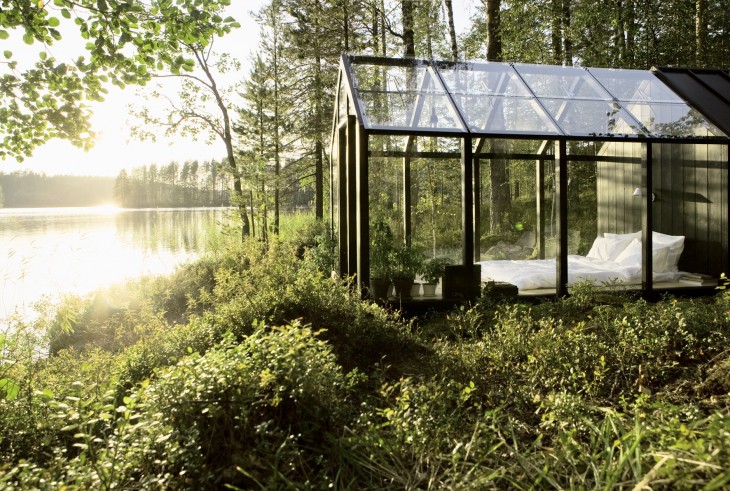Case Study: STUDIOHOUSE-F451
Text: BERNARD RUDOFSKY-Conditioned Outdoor Room
B. Rudovsky tried to analyze lifestyle of modern man and the historical context which determined this kind of lifestyle as well the relationship between lifestyle and architecture. The author argues that the main issue is not that our cities are inhabited, but is there whether future for such way of existence. In fact humanity is moving towards the conquest of nature that prove the benefits of civilization, such as the hot pools in the winter and ice rinks in the summer. At the same time, conquering nature we’ve gone farther and farther from her , New York journalist’s experiment shows this issue very well , he proved that you can lead a relatively normal, socially rich, full life basically not appearing outdoors.
Indeed, people are more and more insulate themselves from the natural world in their monolithic grand building – a monument to human will power and self-righteousness. But don’t you think this idea to bury yourself in these almost perfect, ingenious dwellings makes meaningless the very concept of humanity, we will survive and probably will be happy, but will whether we be humans? In fact we came out of this air, were born in this water, were woven from the same elements that the land, we are inextricably associated with it and the climate in which we live gives us special features, unique to the people living in this climate.
Analyzing various aspects of climate author cites the experience of the twentieth century colonialists and considers the example of these colonies, and also holds the connection between architecture of country-colonizer and new colonies. Rudovsky complains that the first colonies had been miserable villages for a long time reminding rather Indian settlements than fortress of proud pioneers. Construction was not exactly a strong point of the first settlers, and only 120 years later as the first Swedish settlers gave to an audience first Log Cabin can say that started the golden age of the American conquest of nature. And the symbol of this struggle, and this victory was the image of the Log Cabin.
However, what is surprising is that despite the proximity to the ground and an abundance of natural land new settlers did not come up with anything better as just copy the old houses and old typologies of their former homeland. It would seem that the harsh conditions of the North American nature should encourage them to invent new archetypes dwelling, dwelling proud free and democratic citizen of a great country, but there were only copies.The only novelty is the climate control which was and still concerned about the North American residents. But how can you argue that it is a physical and spiritual breakthrough?Perhaps you will feel more alive wake you in an old house where the wind howls and frost patterns can be drawn on glass. Climate control is an old idea that originated in the human mind a long time ago and somehow embodied in all human habitations.But the more comfortable conditions inside the home the less we associate ourselves with the environment, when we talk my space we never have in mind the garden, we always try to separate themselves from nature, and eventually it led to what we are just observers.
The author paid much attention to the study of historical varieties of gardens, and approaches to their design, from this analysis we can conclude that for the existence of mankind had several very different approaches to design and blend of internal and external space. And now we have a great chance to take the best out of this historical experience.Referring to this topic author admires and proclaims manifesto to freestanding wall that is not just a utilitarian object, but the object of art, it is not intended to enclose the space but to transform it.In accordance with this thesis the author considered such a traditional element of the American home as a front lawn, and he states that it is a formal approach to convergence with nature, this is not the solution and not an option, and that now is the time to invent something more revolutionary, something more truthful.
In the context of this study, we also looked at Studio House by F451 Arquitectura. An instance of the private construction relates to the variety Positional relations. This project is interesting because of builded relationships between home and terrain, between the house and the surrounding area, between different spaces within the home, as well as the author’s attempt to make it sustainable.
In light of the above, we can conclude that mankind should reconsider the relationship with nature. This is not a quick process and strongly depends on the research innovations, but maybe we should take as a basis idea that the nature is our religion and the nature is our church, and what could be more natural than when believers come into the temple in search of peace and harmony.
If we talk about personal preferences of research, in this context, I do not feel at the moment the strength to invent a new typology of the relationship between man and nature, there is another aspect of the study that interests me much more. In our increasingly digital world, it seems, we have become absolute deniers of past classical experience, I would like to find a model of the interaction between new digital opportunities and the classical vision to invent a new typology of the building more comfortable, more clearer, more relevant to modern residents. I would also have been interesting to work on the creation of new public spaces. Maybe after some time, the scope of my interests change.

